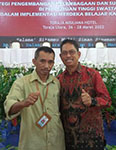Akuatikisle: Jurnal Akuakultur, Pesisir dan Pulau-Pulau Kecil
Full Length Article
Probiotic aplication for growth and survival rate of vaname shrimp Litopenaeus vannamei with different density
Highlights
Generate NLP AI by Wizdam ID.
Abstract
The study aimed to determine the growth and survival of Litopenaeus vannamei shrimp with the application of probiotics to different stocking densities. The study was conducted from May to June 2018 at the Balai Benih Ikan Pantai (BBIP) Ghonebalano, Duruka District, Muna Regency, using a Completely Randomized Design (CRD) with three levels of solid stocking treatment namely treatment A is 18 individu per container, treatment B is 24 individu per container and treatment C is 30 individu per container with three replications. Data analysis using Variance Analysis (ANOVA) at the confidence level of 95% (α 0.05). The results showed that the highest daily growth was obtained at 24 individual densities of 5.88% per day, compared to 18 individual densities of 5.86% per day and 30 individual densities of 5.74% per day. The highest absolute growth is obtained at 24 individual density of 2.43 g per individu, then 18 individual density of 2.15 g per individual, and the lowest at 30 individual density of 2.02 g per individual. Survival at a density of 18 individual and a density of 24 individual at 88.89%, while a 30-ind density of 86.67%. Analysis of variance (α 0.05) showed that the application of probiotics to different stocking densities had no significant effect on the daily growth rate of vannamei shrimp (p<0.939), absolute growth of vannamei shrimp (p<0.080), and survival of vannamei shrimp (p<0.744).
Keywords
Introduction
Section snippets
Material and Methods
Materials and methods from the full-text PDF of this article cannot be displayed.
Results
Results from the full-text PDF of this article cannot be displayed.
Discussion
Discussion from the full-text PDF of this article cannot be displayed.
Conclusions
Conclusions from the full-text PDF of this article cannot be displayed.
Acknowledgment
Acknowledgment from the full-text PDF of this article cannot be displayed.
Funding Information
Program Studi Budidaya Perairan, Sekolah Tinggi Ilmu Pertanian Wuna Raha
Competing interest
The authors declare that they have no known competing financial interests or personal relationships that could have appeared to influence the work reported in this paper.
Conflict of interest
The authors declare that the research was conducted in the absence of any commercial or financial relationships that could be construed as a potential conflict of interest.
Ethical approval acknowledgements
No ethical approval required for this article. All procedures followed were in accordance with the ethical standards of the responsible committee on human experimentation (institutional and national) and with the Helsinki Declaration of 1975, as revised in 2008 (5)
Supplementary files
Data sharing not applicable to this article as no datasets were generated or analysed during the current study, and/or contains supplementary material, which is available to authorized users.
Bibliographic Information
Cite this article as:
-
Submitted
18 December 2017 -
Revised
27 March 2018 -
Accepted
23 November 2018 -
Published
23 November 2018 -
Version of record
13 December 2018 -
Issue date
1 December 2018
-
Academic subject
Aquaculture; Fisheries Science
Copyright
Copyright © 2018 Abdul Rakhfid, Wa Ode Halida, Rochmady, Fendi. Sangia Research Media and Publishing. Production and hosting by Sangia (SRM™).  This work is licensed under a Creative Commons Attribution-ShareAlike 4.0 International License.
This work is licensed under a Creative Commons Attribution-ShareAlike 4.0 International License.
Disclaimer: All claims expressed in this article are solely those of the authors and do not necessarily represent those of their affiliated organizations, or those of the publisher, the editors and the reviewers. Any product that may be evaluated in this article or claim that may be made by its manufacturer is not guaranteed or endorsed by the publisher.




